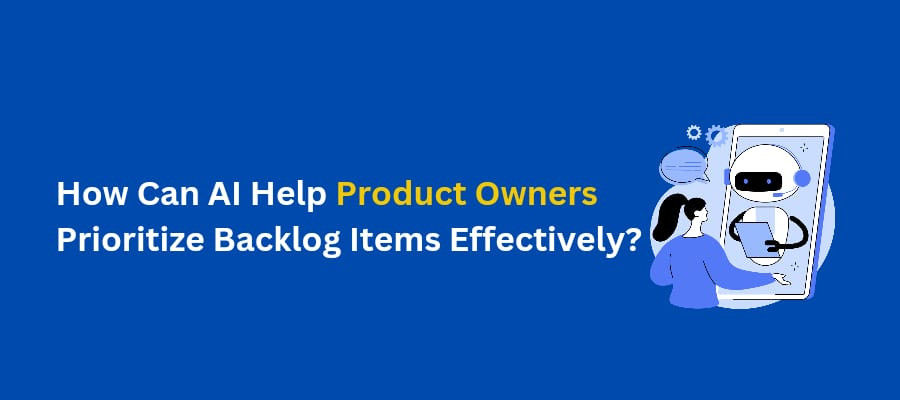AI for Product Owners - How Can AI Help Product Owners Prioritize Backlog Items Effectively?

Backlog prioritization is the beating heart of a Product Owner’s responsibilities, yet it often feels like an intricate balancing act. With competing stakeholder demands, tight deadlines, and rapidly evolving customer needs, prioritizing backlog items can be daunting.
Artificial Intelligence (AI) can be a game-changer for Certified Scrum Product Owners (CSPO) and anyone stepping into the Product Owner role. AI doesn’t just make the process faster; it enables the Product Owners to focus on value-driven decisions. Let’s explore how AI can transform backlog prioritization and help Product Owners shine.
Why Should Product Owners Leverage AI?
AI isn’t here to replace you but to elevate your role. AI tools help you make data-backed decisions and build smooth collaboration between developers and end users. For instance:
- AI can analyze historical sprint data to help product owners prioritize specific backlog items.
- Sentiment analysis tools can help you gauge customer feedback trends, ensuring you align priorities with user needs.
- Forecasting algorithms can simulate various priority combinations to identify the optimal order of work items.
Embracing AI amplifies your efficiency and empowers you to focus on strategy, innovation, and stakeholder alignment.
Using AI To Refine Backlog Prioritization Frameworks
Most Product Owners know frameworks like MoSCoW, Value vs. Effort, or the RICE scoring model. While these frameworks are excellent, they can become tedious when handling a backlog bursting with hundreds of items. AI can streamline these processes by automating the heavy lifting and providing more profound insights. For example:
- Tools like Jira Align or Aha! can apply scoring frameworks automatically, analyzing effort estimates and projected customer impact to prioritize items.
- AI tools such as Airfocus can help assign values to backlog items using a combination of customer feedback, usage data, and team capacity, saving hours of manual calculation.
With AI, you’re not just guessing; you’re prioritizing based on hard data, ensuring every sprint is aligned with business and customer goals.
Customer Insights With AI: What’s Driving Your Users?
A big part of backlog prioritization lies in understanding what your customers want—often before they know it themselves. AI tools excel in this area by analyzing massive datasets to uncover trends, pain points, and opportunities.
Here’s how you can leverage AI for customer insights:
- Sentiment Analysis: Tools like MonkeyLearn and Clarabridge analyze customer reviews, support tickets, and social media mentions to identify what users love and where they’re struggling.
- Behavioral Analytics: Platforms like Mixpanel and Heap track user behavior across your product, highlighting underused features or common friction points.
- Churn Prediction: AI-driven tools such as Pendo can identify early warning signs of customer churn, ensuring critical backlog items addressing retention are prioritized.
These insights provide a robust foundation for your prioritization efforts, helping you deliver what truly matters to your users.
Forecasting Outcomes With AI-Driven Simulations
Predictive modeling is one of AI's most exciting applications in backlog management. Imagine simulating the impact of implementing a specific backlog item before committing to it—AI makes this possible. For example:
- Roadmunk offers predictive analytics that simulates how delivering a particular feature affects customer satisfaction and business metrics.
- Craft.io uses historical data to predict development timelines, enabling you to sequence backlog items more effectively.
- AI algorithms can also flag risks, such as dependencies or resource bottlenecks, helping you plan smarter.
By experimenting with these “what-if” scenarios, you can make data-informed decisions that optimize ROI and mitigate risks.
Streamlining Stakeholder Collaboration With AI
Stakeholders often have strong opinions about what should come first in the backlog. As a Product Owner, mediating these perspectives while staying true to the product vision can be tricky. AI can help you balance these dynamics by providing an objective lens.
Here’s how:
- AI-Powered Roadmaps: Tools like ProdPad and ProductPlan create dynamic roadmaps that automatically adjust based on priority changes or resource constraints, giving stakeholders a clear, real-time view of trade-offs.
- Prioritization Workshops: Use tools like Stormboard or Miro with integrated AI to facilitate backlog refinement sessions, identifying top-priority items collaboratively based on pre-set criteria.
Pro Tip: AI tools can summarize stakeholder inputs from meetings or emails, giving a concise overview of everyone’s priorities to guide backlog refinement sessions.
Improving Sprint Readiness With AI
A well-prioritized backlog is only half the battle; ensuring it’s sprint-ready is just as critical. AI tools can help Product Owners refine backlog items to be clear, actionable, and aligned with the Definition of Ready (DoR).
Some practical uses:
- Natural Language Processing (NLP): Tools like Grammarly for Jira ensure backlog items are written and free of ambiguity, enhancing developer understanding.
- Dependency Identification: AI tools like Azure DevOps can automatically flag dependencies between user stories, ensuring smooth sprint planning.
- Effort Estimation: Platforms such as Plutora use historical data to provide realistic effort estimates, reducing guesswork during planning.
These capabilities free up your time for higher-level strategic tasks while ensuring your team has everything they need to execute efficiently.
Final Thoughts: AI Can Be Your Product Management Superpower!
AI isn’t just a tool—it’s a competitive edge. By leveraging AI, Certified Scrum Product Owners (CSPOs) can move beyond manual processes and guesswork, focusing instead on delivering value and driving product success.
Here’s what you can achieve with AI:
- Gain actionable insights from customer data.
- Optimize prioritization frameworks with precision.
- Predict outcomes and manage risks effectively.
- Collaborate seamlessly with stakeholders and teams.
Ready to amplify your skills as a Product Owner? Consider becoming a Certified Scrum Product Owner (CSPO) with PremierAgile. Our training programs equip you with the expertise to embrace AI tools and elevate your product management game.
Take the leap and become the tech-savvy Product Owner every team dreams of having!
Reference:
https://community.atlassian.com/t5/Agile/How-AI-Empowers-Product-Owners-Enhancing-Decision-Making-and/ba-p/2433419
https://www.ankitgarla.com/post/beyond-user-stories-prioritizing-backlogs-with-ai-and-machine-learning




